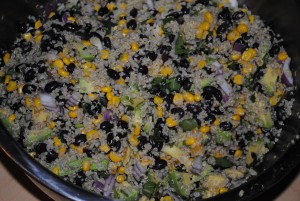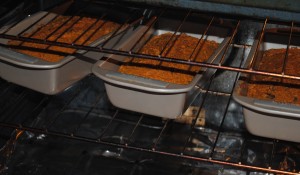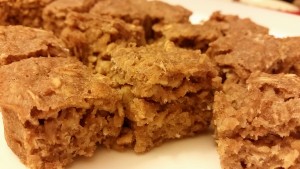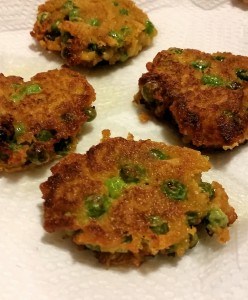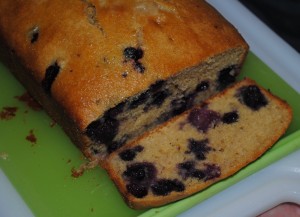
By Alaina Coffey, Senior Dietetics Student, Sargent College
Students baked blueberry lemon yogurt cake and thoroughly enjoyed this tasty treat at Wednesday night’s test kitchen. After baking and taste testing, students recommended that this recipe should be called a bread rather than a cake. What makes this bread so healthy, compared to conventional pound cakes and quick breads, is the recipe’s use of whole wheat flour as a base, fat-free plain yogurt as a binding agent, and extra-virgin olive oil instead of butter. Honey, lemon zest, and blueberries contribute sweetness to the bread, so not much added sugar is necessary. This bread contains wholesome, healthy ingredients and still tastes like a decadent treat!
We made a few adjustments to our SCTK version of the recipe when preparing blueberry lemon yogurt bread. The bread took longer than the suggested 55 minutes to bake through the center, so Karen increased the oven temperature from 325 to 350 after the bread had been baking for 50 minutes. Student suggestions included that the bread was very lemony and perhaps the amount of lemon zest could be decreased, but overall, students enjoyed eating the bread and several batches quickly disappeared! This bread is a perfect springtime treat, the recipe is simple, and preparation time is quick. Try it at home and incorporate your own favorite fresh or frozen fruits such as raspberries, blackberries, or strawberries, or even dried fruits such as dates or apricots. The wholesome ingredients in this bread make it a healthier alternative to traditional pound cakes and quick breads, and further, you will be satisfied with the delicious taste!
Sargent Choice
Blueberry Lemon Yogurt Cake
Recipe modified from Cookie and Kate
Yield: Recipe makes one loaf (12 servings)
Ingredients
1 ½ cups white whole wheat flour, plus more for dusting
2 teaspoons baking powder
½ teaspoon sea salt
2 medium lemons, to be zested and juiced
2/3 cup granulated sugar
3 extra large eggs
½ teaspoon pure vanilla extract
½ cup extra-virgin olive oil
1 cup fresh or frozen blueberries (if frozen, do not defrost)
2 teaspoons honey
Directions
1. Preheat oven to 325 degrees. Lightly grease 8 ½ by 4/1/4 by 2 ½-inch loaf pan with butter and flour and set aside.
2. In a medium mixing bowl, whisk together flour, baking powder and salt.
3. Pour the sugar into a separate medium-sized mixing bowl. Grate all the zest from the lemons. Rub the zest into the sugar until the sugar is yellow and fragrant. Add the yogurt, eggs and vanilla to the sugar mixture. Whisk well, until the ingredients are combined.
4. When the mixture is well blended, gently whisk in the dry ingredients, just until incorporated. Switch to a spatula and fold in the oil, making sure it’s all incorporated. The batter will be shiny. In a separate bowl, toss the blueberries with about one teaspoon flour (this will help prevent them from sinking while the cake bakes). Gently fold the blueberries into the batter.
5. Pour the batter into the prepared loaf pan and smooth the top. Bake the cake for 50-55 minutes, or until the top is golden and the sides just start to pull away from the sides of the pan. A toothpick inserted into the center should come out clean.
6. Let the cake cool in the pan for 30 minutes. Meanwhile, warm 2 tablespoons lemon juice and 2 teaspoons honey just long enough for you to whisk the honey into the juice. Using a pastry brush, brush the lemon-honey glaze on top of the warm cake. Repeat until you have no more liquid left.
7. Run a knife between the cake and sides of the pan to loosen. Unmold the cake by placing a large plate of cutting board upside down over the loaf pan and carefully turning it over. Cool. Slice and serve.
| Nutrition | Per serving |
| Calories | 220 |
| Fat | 12 g |
| Saturated Fat | 2 g |
| Protein | 4 g |
| Carbohydrate | 27 g |
| Fiber | 2 g |
